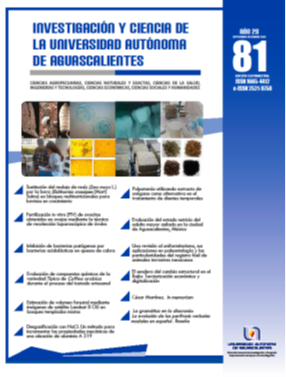Pulpotomía utilizando extracto de orégano como alternativa en el tratamiento de dientes temporales
DOI:
https://doi.org/10.33064/iycuaa2020813230Palabras clave:
pulpotomía, lesión cariosa, pulpa dental, cámara pulparResumen
El formocresol es uno de las sustancias más empleadas para la terapia dental de la pulpotomía en la Odontpediatría debido a sus efectos tóxicos, genotóxicos y mutagénicos; por dicha razón es que se está constantemente buscando nuevas alternativas para dicho tratamiento con el uso de distintas sustancias o medicamentos. Este es un estudio experimental básico en donde se recolectaron 20 muestras de órganos dentarios de pacientes con edades que oscilaban entre los tres y nueve años de la Clínica de Odontopediatría de Pregrado de la Facultad de Estomatología de la U. A. S. L. P. que cumplieron con los criterios de inclusión para el tratamiento de pulpotomías. El tratamiento se realizó de acuerdo con los lineamientos de la AAPD, con excepción de que se utilizó extracto hidroalcohólico 70:30 de orégano y se midió en el laboratorio su capacidad para eliminar microorganismos.
Descargas
Citas
• Al Dhareri, Y., Eid, A., AbuQamar, S., Attoub, S., Khasawneh, M., Aiche, G., … Iratni, R. (2013). Mitotic arrest and apoptosis in breast cancer cells induced by Origanum majorana extract: Upregulation of TNF-α and downregulation of survivin and mutant p53. PLoS ONE, 8(2), e56649. doi: 10.1371/journal. pone.0056649
• Anderson, J. D. (2000). Need for evidence-based practice in prosthodontics. The Journal of Prosthetic Dentistry, 83(1), 58-65.
• Calatayud, J., Casado, I., & Álvarez, C. (2006). Análisis de los estudios clínicos sobre la eficacia de las técnicas alternativas al formocresol en las pulpotomías de dientes temporales. Avances en Odontoestomatología, 22(4), 229-239.
• Casas, M. J., Kenny, D. J., Johnston, D. H., Judd, P. L., & Layug, M. A. (2004). Outcomes of vital primary incisor ferric sulfate pulpotomy and root canal therapy. Journal (Canadian Dental Association), 70(1), 34-38.
• Fox, A. G., & Heeley, J. D. (1980). Histological study of pulps of human primary teeth. Archives of Oral Biology, 25(2), 103-110.
• Fuchino, T. (1980). [Clinical and histopathological studies of pulpectomy in deciduous teeth (author’s transl)]. Shikwa Gakuho Dental Science Reports, 80(7), 971-1017.
• Fuks, A. B. (2002). Current concepts in vital primary pulp therapy. European Journal of Paediatric Dentistry, 3(3), 115-120.
• Fuks, A. B. (2008). Vital pulp therapy with new materials for primary teeth: New directions and treatment perspectives. Pediatric Dentistry, 30(3), 211-219(9).
• García-Perez, E., Noratto, G. D., García-Lara, S., Gutiérez-Uribe, J. A., & Mertens-Talcott, S. U. (2013). Micropropagation effect on the anticarcinogenic activity of polyphenolics from Mexican oregano (Poliomintha glabrescens gray) in human colon cancer cells HT-29. Plant Foods for Human Nutrition, 68(2), 155-162. doi: 10.1007/s11130-013-0344-2
• International Agency for Research on Cancer & Wold Health Organization. (2004). IARC classifies formaldehyde as carcinogenic. Oncology Times, 26(13), 72. doi: 10.1097/01.COT.0000292246.11180.99
• Kelmanson, J. E. (2000). Zulu medicinal plants with antibacterial activity. Journal of Ethnopharmacology, 69(3), 241-246. doi: 10.1016/s0378-8741(99)00147-6
• Miller, W. D. (1883). Dental caries. American Journal of Dental Science, 17(3), 126-130.
• Miller, W. D. (1884). Micro-organisms and dental caries. The American Journal of Dental Science, 18(4), 164-173.
• Milnes, A. R. (2002). Is formocresol obsolete: A fresh look at the evidence. Pediatric Dentistry, 30(3), 237-246.
• Orellana-Centeno, J. E., González-Quintero, J. S., Nava-Calvillo, J. F., Nava-Zárate, N., Olvera-Gutiérrez, N., Orellana-Centeno, M., & Ponce-Palomares, M. (2012). Cloruro de aluminio una alternativa en pulpotomías de dientes temporales. Revista Latinoamericana de Ortodoncia y Odontopediatria Ortodoncia.ws edición electrónica. Recuperado de https://www.ortodoncia.ws/publicaciones/2012/art-7/
• Orellana-Centeno, J. E., González-Quintero, J. S., Nava-Calvillo, J. F., Olvera, N., Orellana-Centeno, M., & Ponce-Palomares, S. (2010). Pulpotomía infantil utilizando ungüento oftálmico como método alternativo al uso de formocresol. Revista Latinoamericana de Ortodoncia y Odontopediatria Ortodoncia.ws edición electrónica. Recuperado de www.ortodoncia.ws
• Pimentel Ramírez, E., Castillo Andamayo, D., Quintana del Solar, M., Maurtua Torres, D., Villegas Vílchez, L., Díaz Santisteban, C. (2015). Efecto antibacteriano de extractos etánolicos de plantas utilizadas en las tradiciones culinarias andinas sobre microorganismos de la cavidad bucal. Revista de Estomatología Herediana, 25(3), 268-277.
• Ranly, D. M. (1994). Pulpotomy therapy in primary teeth: New modalities for old rationales. Pediatric Dentistry, 16(6), 403-409.
• Samra de Quintero, P. A., Rivera Fuenmayor, N., Bernardoni de Socorro, C., Arteaga de Vizcaíno, M., & Finol Bravo, A. (2008). Epidemiología de las urgencias odontológicas en niños atendidos en la Facultad de Odontología de la Universidad del Zulia. Ciencia Odontológica, 5(2), 134-144.
• Schovelin, H. A., & Muñoz C., M. (2018). Efecto antibacteriano de la infusión de orégano (Origanum vulgare) sobre el crecimiento in vitro de Streptococcus mutans. International Journal of Odontostomatology, 12(4), 337-342.
• Soto-Domínguez, A., García-Garza, R., Ramírez-Casas, Y., Morán-Martínez, J., & Serrano-Gallardo, L. B. (2012). El extracto acuoso de orégano (Lippia graveolens HBK) del norte de México tiene actividad antioxidante sin mostrar un efecto toxico in vitro e in vivo. International Journal of Morphology, 30(3), 937-944.
• Torabinejad, M., Kutsenko, D., Machnick, T. K., Ismail, A., & Newton, C. W. (2005). Levels of evidence for the outcome of nonsurgical endodontic treatment. Journal of Endodontics, 31(9), 637-646.
• Vij, R., Coll, J. A., Shelton, P., & Farooq, N. S. (2004) Caries control and other variables associated with success of primary molar vital pulp therapy. Pediatric Dentistry, 26(3), 214-220.
• Waterhouse, P. J. (2008). “New age” pulp therapy: Personal thoughts on a hot debate. Pediatric Dentistry, 30(3), 247-252.
Publicado
Versiones
- 2020-11-30 (2)
- 2020-11-30 (1)
Cómo citar
Licencia
Derechos de autor 2020 José Eduardo Orellana-Centeno, Darío Gaytán-Hernández, Jaime Francisco Nava-Calvillo

Esta obra está bajo una licencia internacional Creative Commons Atribución-NoComercial-CompartirIgual 4.0.
Las obras publicadas en versión electrónica de la revista están bajo la licencia Creative Commons Atribución-NoComercial-CompartirIgual 4.0 Internacional (CC BY-NC-SA 4.0)









